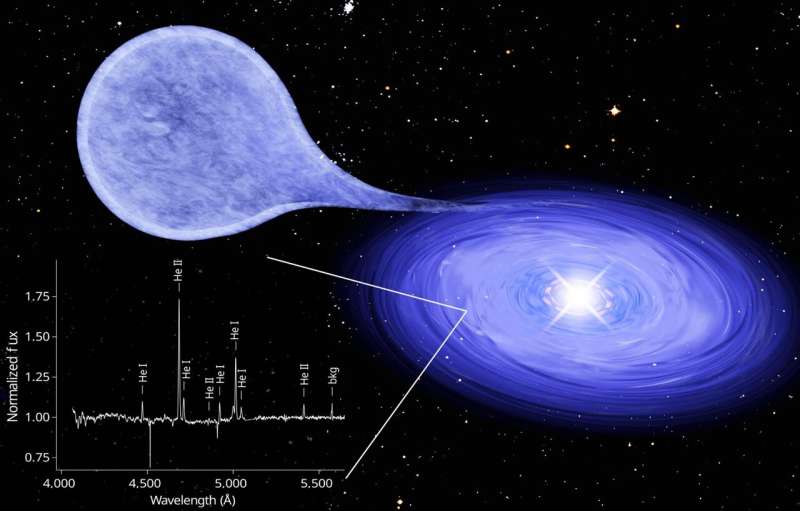This article has been reviewed according to Science X's editorial process and policies. Editors have highlighted the following attributes while ensuring the content's credibility:
fact-checked
peer-reviewed publication
trusted source
proofread
Astronomers discover helium-burning white dwarf

A white dwarf star can explode as a supernova when its mass exceeds the limit of about 1.4 solar masses. A team led by the Max Planck Institute for Extraterrestrial Physics (MPE) in Garching and involving the University of Bonn has now found a binary star system in which matter flows onto the white dwarf from its companion.
The system was found due to bright, so-called super-soft X-rays, which originate in the nuclear fusion of the overflowed gas near the surface of the white dwarf. The unusual thing about this source is that it is helium and not hydrogen that overflows and burns. The measured luminosity suggests that the mass of the white dwarf is growing more slowly than previously thought possible, which may help to understand the number of supernovae caused by exploding white dwarfs. The results have been published in the journal Nature.
Exploding white dwarfs are not only considered the main source of iron in the universe, they are also an important tool for cosmology. As so-called Type Ia supernovae (SN Ia), they all become roughly equally bright, allowing astrophysics a precise determination of the distance of their host galaxies.
However, even after many years of intensive research, it remains unclear under what circumstances the mass of a white dwarf can grow to the so-called Chandrasekhar limit. This is the theoretical upper limit for the mass of a white dwarf, derived in 1930 by Indian-American astrophysicist and Nobel laureate Subrahmanyan Chandrasekhar.
In the early 1990s, super-soft X-ray sources with stable hydrogen burning on their surfaces were established as a new class of objects with ROSAT, and for a time those were considered potential candidates for SN Ia progenitors. The problem with these sources, however, is their hydrogen abundance: type Ia supernovae show no trace of hydrogen.
For more than 30 years, double star systems have been predicted, in which a white dwarf accretes and burns helium stably at its surface, but such sources have never been observed. An international team led by the Max Planck Institute for Extraterrestrial Physics (MPE) has now found an X-ray source whose optical spectrum is completely dominated by helium.
"The super-soft X-ray source [HP99] 159 has been known since the 1990s, when it was first observed with ROSAT, more recently with XMM-Newton and now with eROSITA," explains Jochen Greiner, who leads the analysis of this source at MPE. "Now, we were able to identify it as an optical source in the Large Magellanic Cloud. In its spectrum we found mainly emission lines of helium originating from the accretion disk."
However, this does not solve the problem of SN Ia progenitors: theoretical models predict that about 2-5% of the matter of the helium companion star will be carried away by the SN Ia explosion and ejected into the environment. However, this amount of helium has not been found in most supernovae Ia observed to date. There is, however, a subclass with smaller luminosity, the SN Iax, in which the explosion is weaker, and therefore less helium is blown away.
The now discovered system [HP99] 159 could end up in such a SN Iax according to current knowledge, since the measurements here indicate that continuous helium burning in white dwarfs is possible even at lower accretion rates than theoretically predicted. The measured luminosity of [HP99] 159 is about ten times smaller than expected at the canonical rate, while at the same time the measured X-ray temperature is exactly in the expected range for stable helium burning.
"The observed X-ray brightness suggests that the burning of the inflowing helium in the white dwarf is stabilized by its rapid rotation, making a final supernova explosion of the system likely," says Prof. Dr. Norbert Langer of the Argelander Institute for Astronomy, who is also a member of the Matter Transdisciplinary Research Area at the University of Bonn.
Since previous measurements indicate that the luminosity has remained the same for about 50 years, a wide range of accretion rates leading to explosions should be possible.
"Stars without hydrogen envelopes, such as the companion star found in [HP99] 159, are an important intermediate step in the life cycle of binary stars that should occur in about 30% of such systems," says Julia Bodensteiner of ESO, who has been studying massive stars since her master's thesis at MPE. "There should be many such stars; but only a few have been observed so far."
The team now hopes to find dozens of similar sources in the two Magellanic Clouds with eROSITA. This should allow them to further constrain the conditions for SN Ia progenitors.
More information: J. Greiner et al, A helium-burning white dwarf binary as a supersoft X-ray source, Nature (2023). DOI: 10.1038/s41586-023-05714-4
Journal information: Nature
Provided by University of Bonn




















